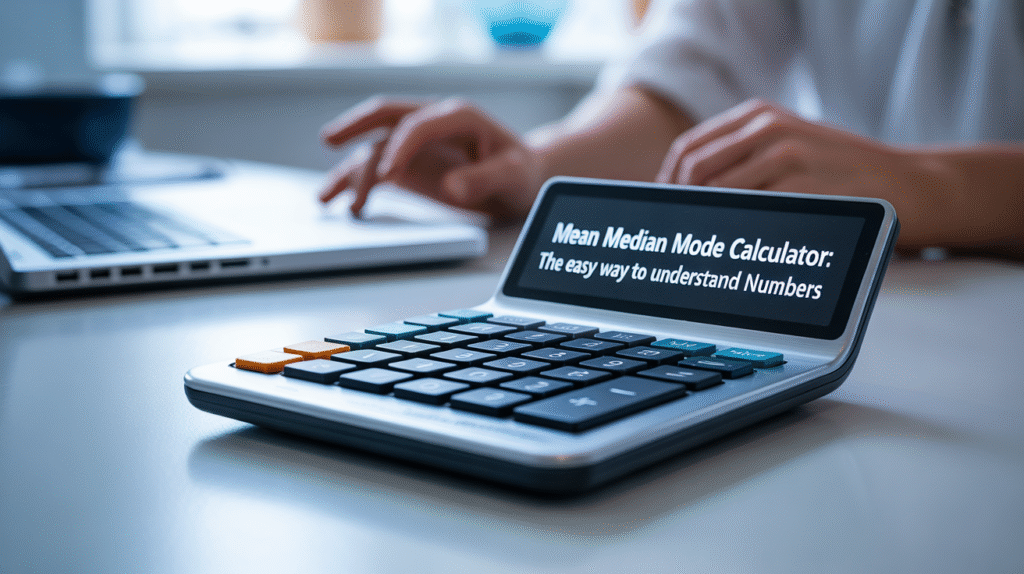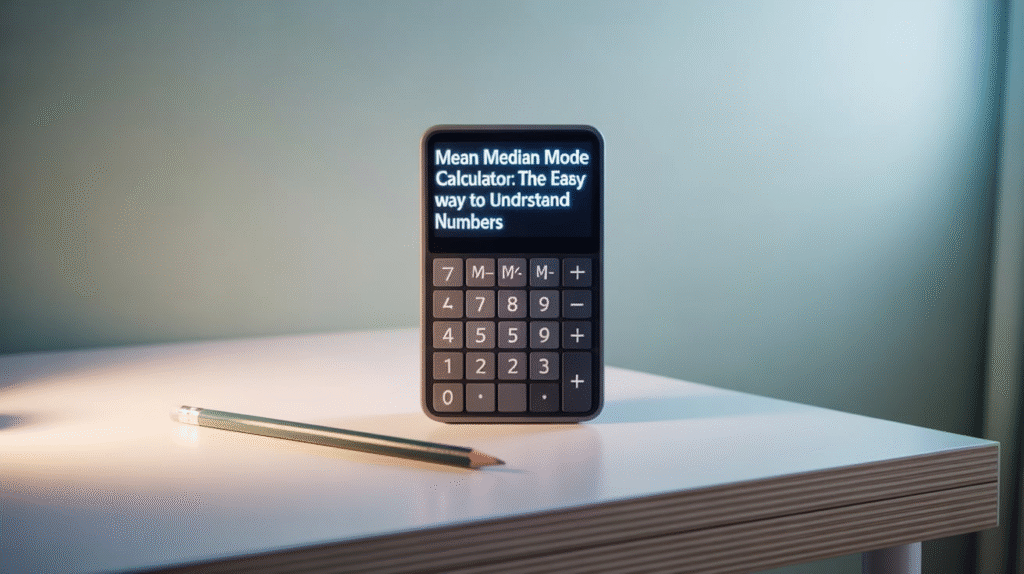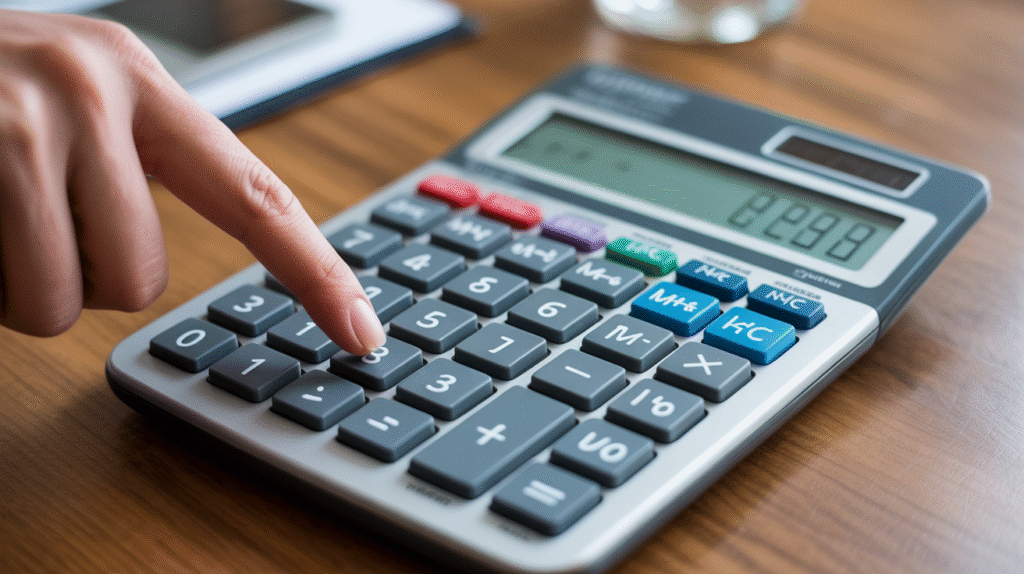Have you ever looked at a list of numbers and wondered what they really mean? Maybe you have test scores, expenses, or survey results, and you just want a quick summary. That’s where a mean median mode calculator becomes your best friend. It helps you understand the “story” behind the numbers in seconds.
In this guide, we’ll explore what the mean, median, and mode really are, how to use a mean median mode calculator, and why these simple tools are more powerful than they seem. We’ll use real-life examples, simple explanations, and helpful tips so that even math feels fun!
Table of Contents
What Is a Mean Median Mode Calculator?

A mean median mode calculator is an online tool that quickly finds three key statistics:
- Mean – the average of the numbers.
- Median – the middle number when the data is sorted.
- Mode – the most frequent number in the list.
Instead of doing the math by hand, you just type in your numbers, press a button, and the calculator gives you the answers instantly. It saves time and prevents mistakes, especially when you’re working with lots of data.
For example, if your test scores are 80, 85, 90, 85, 95, you can pop those into the calculator and get all three results right away. Easy, right?
Why These Three Numbers Matter
Understanding mean, median, and mode helps you see patterns in your data. Each one tells a slightly different story.
- The Mean shows the overall average.
- The Median shows the middle value, which helps you see the “typical” case.
- The Mode shows the most common value — what happens most often.
For example, if you want to know the average amount students scored on a test, use the mean. But if one student got a very low or high score, that can throw off the mean. The median might give a better idea of what most students scored.
These simple numbers help teachers, business owners, and even kids understand data more clearly.
How to Calculate the Mean (Average)

Let’s start with the mean, often called the average.
To find it manually:
- Add up all the numbers.
- Divide by how many numbers there are.
Example:
If your numbers are 4, 8, and 10:
- Add them → 4 + 8 + 10 = 22
- Divide by 3 → 22 ÷ 3 = 7.33
So, the mean is 7.33.
When you use a mean median mode calculator, it does this instantly — no calculator or paper needed!
How to Find the Median (Middle Value)
The median is the middle number in a list once the numbers are sorted.
Steps to find it manually:
- Arrange the numbers in order.
- Find the middle one.
Example:
Numbers → 2, 5, 7, 10, 12
The middle number is 7, so that’s the median.
If there’s an even number of values, like 2, 4, 6, 8,
you take the two middle numbers (4 and 6), add them, and divide by 2 → 5.
Using a mean median mode calculator saves you the effort, especially for long lists!
How to Find the Mode (Most Common Value)

The mode is the number that appears most often in a set.
Example:
For 1, 3, 3, 5, 7, 3 — the mode is 3, since it appears three times.
Some data sets can have:
- One mode (unimodal)
- Two modes (bimodal)
- No mode if all numbers appear only once
A mean median mode calculator will tell you automatically if there are multiple modes or none at all.
Why Use an Online Mean Median Mode Calculator?
You might wonder, “Can’t I just do this with a regular calculator?” Sure — but that can take time, especially with big data sets.
Online mean median mode calculators are faster, smarter, and less error-prone. You just paste your numbers, click “Calculate,” and instantly get:
- Mean
- Median
- Mode
- Range (sometimes included)
Many calculators also show step-by-step solutions, helping you learn while saving time.
Whether you’re a student, teacher, or data lover, it’s a helpful way to double-check your answers.
Real-Life Examples of Using Mean, Median, and Mode
Let’s see how these three measures work in everyday life:
- Classroom Grades: Teachers can use a mean median mode calculator to find the average score of their class and see if most students are performing similarly.
- Business Sales: A shop owner can use it to analyze daily sales — the mean shows average income, and the mode might show the most common purchase amount.
- Weather Reports: Meteorologists use these calculations to find typical temperatures over a month or year.
- Sports Stats: Coaches use them to see player averages, like average runs or goals scored.
In all these cases, the mean median mode calculator helps turn plain numbers into useful insights.
Mean vs. Median vs. Mode: Which One Should You Use?
Sometimes, people ask, “Which one is best — mean, median, or mode?” The answer depends on what you want to know.
- Use the mean when you want a total average.
- Use the median when you want the middle value (good for avoiding outliers).
- Use the mode when you want to know what happens most often.
Example:
Imagine you’re looking at house prices: $100,000, $120,000, $130,000, $500,000.
The mean might seem high because of that $500,000 house.
But the median ($125,000) shows what a “typical” house costs.
So, each value has its own purpose — and a mean median mode calculator helps you see them all together.
Tips for Using a Mean Median Mode Calculator Effectively
To get accurate results, follow these simple tips:
- Double-check your data: Make sure all numbers are entered correctly.
- Remove symbols or spaces: Most calculators only accept numbers separated by commas or spaces.
- Include all values: Leaving out one can change the mean or median.
- Use decimals correctly: Some calculators may round off your numbers.
The cleaner your data, the more accurate your results.
Remember: a mean median mode calculator can’t fix data errors — it only works with what you give it.
Advantages of Mean Median Mode Calculators
Let’s look at why people love using these tools:
- Time-saving: Get answers in seconds.
- Error-free: No manual math mistakes.
- Educational: Learn how mean, median, and mode relate to your data.
- Versatile: Useful for school, work, and research.
Best of all, most online calculators are free and easy to access from your phone or computer.
They make statistics approachable — even for kids who think math is tough!
Top Features to Look for in a Good Calculator
Not all mean median mode calculators are created equal. When choosing one, look for:
- A simple interface (easy to type or paste numbers)
- Step-by-step explanations
- Support for large data sets
- Options to find range and standard deviation
- Ability to download or copy results
Some even include colorful charts to visualize your data. These extras help make math more engaging and easier to understand.
How Mean, Median, and Mode Help in Decision-Making
Numbers aren’t just for math class — they guide real-world decisions every day.
Businesses use averages to set prices. Teachers use medians to see class progress. Health experts use modes to find common symptoms or trends.
For example, a doctor might notice that the mode for patient blood pressure readings is a bit high. That clue helps spot early health risks.
A mean median mode calculator makes such insights easy, even if you’re not a math expert.
Fun Fact: Mean, Median, and Mode in Pop Culture
Believe it or not, these math ideas pop up in unexpected places!
In sports broadcasts, you often hear about a player’s average score — that’s the mean.
When TV news reports on “typical income,” that’s the median.
And when social media talks about “most popular” trends — that’s basically the mode!
Using a mean median mode calculator helps you understand the numbers behind the headlines.
Common Mistakes to Avoid
Here are some common errors people make:
- Mixing up the mean and median
- Forgetting to sort numbers before finding the median
- Using words or symbols in the calculator input
- Ignoring outliers that can affect averages
Always double-check your list before clicking “calculate.” A small mistake can change the result.
A good mean median mode calculator often alerts you if there’s an issue with your input — another reason they’re so handy!
FAQs About Mean Median Mode Calculators
1. What is a mean median mode calculator used for?
It helps you quickly find the average (mean), middle (median), and most common (mode) numbers in a data set.
2. Are online calculators accurate?
Yes! If you enter your numbers correctly, most online tools give 100% accurate results.
3. Can I use it for decimals or negatives?
Absolutely. Most calculators accept decimals, fractions, and even negative numbers.
4. Is it free to use?
Many good mean median mode calculators are completely free and available online.
5. Do I need to sign up or download anything?
Usually not. Most tools work right in your browser — no account or download needed.
6. Can I calculate the range too?
Yes. Some calculators include the range, which shows the difference between the highest and lowest numbers.
Conclusion: Math Made Simple for Everyone
Math doesn’t have to be scary or complicated. With a mean median mode calculator, anyone can understand data — fast and easily. It turns long lists of numbers into clear answers that make sense.
Whether you’re a student trying to understand grades, a business owner studying sales, or just someone curious about data, this simple tool can make your life easier.
So go ahead — try a mean median mode calculator today. Once you see how simple and fun it is, you’ll never look at numbers the same way again!




